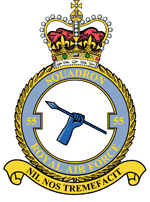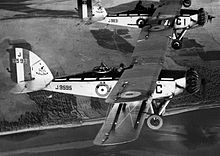No. 55 Squadron RAF
| No. 55 Squadron RAF | |
|---|---|
 | |
| Active | 27 April 1917 – 1 April 1918 (RFC) 1 April 1918 – 22 January 1920 (RAF) 1 February 1920 – 1 November 1946 1 September 1960 – 15 October 1993 15 October 1993 – 31 March 1996 1 November 1996 – 20 January 2011 |
| Country | |
| Branch | |
| Type | Flying squadron |
| Motto(s) | Latin:Nil nos tremefacit (Nothing shakes us)[1][2] |
| Battle honours |
|
| Insignia | |
| Squadron badge heraldry | A cubit arm, the arm grasping a spear |
Number 55 Squadronwas aflying squadronof theRoyal Air Force(RAF). First formed in April 1917, the squadron saw action on theWestern Frontduringthe First World War.Based in the Middle East during theinterwar periodand theSecond World War,No. 55 Squadron saw action over Iraq, Egypt, Libya and Italy. Between 1960 and 1993, the unit flew theHandley Page Victor.Initially on the Victor B.1A before becoming a tanker squadron in 1965 with the Victor B(K).1A/K.1/K.1A before converting to the Victor K.2 in 1975. Disbanding in October 1993, No. 55 Squadron were the last RAF unit to operate the Victor. Between 1996 and 2011, No. 55(Reserve) Squadron operated theHawker Siddeley Dominie T.1fromRAF Cranwell,Lincolnshire, helping to trainnavigatorsfor the RAF.[3]
History
[edit]First World War
[edit]No. 55 Squadron was formed during theFirst World WaratCastle Bromwich,West Midlands, on 27 April 1916.[4]It initially operated as a training unit, flying a mixture of aircraft types, including theAvro 504,Royal Aircraft Factory B.E.2,and theArmstrong Whitworth F.K.8,but in January 1917 it changed its role to a day-bomber squadron, and re-equipped with theAirco DH.4,being the first squadron to receive the new light bomber.[1][5][6][7]
It took these to theWestern Frontin France on 6 March that year as part of 9th Wing, flying its firstbombingmission againstValenciennesrailway station on 23 April 1917 in support of theBattle of Arras.[8]Having been based atTantonvillewhere muddy conditions hampered operations, it moved at the beginning of June 1918 toAzelot.[9]It became part of theIndependent Air Forceas part of No 41 Wing,[10]carrying out daylight strategic bombing missions against targets in Germany, along withreconnaissanceduties.[1][6]55 Squadron developed tactics of flying in wedge formations, bombing on the leader's command and with the massed defensive fire of the formation deterring attacks by enemy fighters.[11]Despite heavy losses, 55 Squadron continued in operation, the only one of the day bombing squadrons in the Independent Force which did not have to temporarily stand down owing to aircrew losses.[12]The squadron flew 221 bombing missions during the war, dropping approximately 141long tons(143,000kilograms) of bombs during the war.[13]
Following theArmisticeon 11 November 1918, 55 Squadron was briefly used to runairmailservices to British forces, before returning to the United Kingdom and relinquishing its aircraft in January 1919,[1]formally disbanding on 22 January 1920.[5]
Between the Wars
[edit]
The squadron reformed on 1 February 1920, whenNo. 142 Squadron,based atSuezand equipped withAirco DH.9swas renumbered.[1]It started to receive more capableAirco DH.9Asin June 1920, and was equipped with a mixture of DH.9s and DH.9As when it transferred to Turkey onboardHMSArk Royalin July to support the 'Q Force' of the British Army who weredefending Constantinople and the Dardanelles.[1][14][15]
55 Squadron moved toIraqin August 1920 to take up 'air policing' duties.[1]It arrived inBaghdadin September 1920, discarding its remaining DH.9s to standardise on the DH.9A.[16]The squadron moved toMosulin March 1921, and toRAF Hinaidiin May 1924.[16]It remained in Iraq for 19 years, on occasion flying air policing operations against rebelling tribesmen. The ageing DH.9As were replaced byWestland Wapitisin February 1930, which in turn were replaced byVickers Vincentsin 1937,[1][17]taking these toRAF Habbaniyain September that year.[16]
It finally received modernmonoplanesin March 1939, when it received twin-enginedBristol Blenheimbombers, transferring toEgyptjust before the outbreak of theSecond World War.[1][17]
Second World War
[edit]No. 55 Squadron flew its Bristol Blenheims on shipping patrols over theGulf of Suez,untilItalydeclared war in June 1940, when 55 Squadron changed to operations against bombing targets inLibya.[1]On 11 June 1940, the unit participated in the first attack by the Royal Air Force on the Italian air force base atEl Adem,where 18 aircraft were destroyed or damaged on the ground, against the loss of three British aircraft from three squadrons.[18]It changed to anti-shipping operations in September 1941, continuing these operations until it was withdrawn from operations in March 1942 for conversion toMartin Baltimores,[1]after which it returned to the bombing role.[17]The squadron continued in support of theEighth Armyfor the remainder of theNorth African campaign.[1]
It flew its Baltimores on bombing raids in support of theAllied invasion of Sicily,and the subsequentinvasion of Italy.It re-equipped withBostonlight bombers in October 1944.[1][17]The squadron moved toHassaniinGreecein September 1945,[1]replacing its Bostons withde Havilland Mosquitosin June 1946. 55 Squadron disbanded in December 1946, and was removed from the RAF's Order of Battle.[1][5]
Handley Page Victor
[edit]

Following a hiatus of nearly fourteen years, No. 55 Squadron reformed atRAF Honingtonin Suffolk on 1 September 1960 equipped with theHandley Page Victor,[5]when it became part of theV bomberforce ofRAF Bomber Command.[1]55 Squadron became the fifth Victor squadron when it receivedVictor B.1Avariant.[19]When theVickers Valiant(a V force stable-mate) was grounded in December 1964 owing tometal fatigue,the Royal Air Force lost itsaerial refuellingtanker force, and a rush programme was launched to convert Victor B.1s to fill the tanker gap. From May 1965, when 55 Squadron moved toRAF Marhamin Norfolk,[16]it received six interim two-pointVictor BK.1A tanker conversions,[1]allowing it to become operational in the air-to-air refuelling tanker role in August 1965.[20]It had replaced the interim BK.1As with the definitive three-point tankers (Victor K.1 and K.1A) by December 1966, retaining them until 1975, when they were replaced by the more powerful Victor K.2.[17]
55 Squadron provided aerial tanker support during Operation Corporate, theFalklands Warin 1982.[1]This notably included theOperation Black Buckraids onStanley Airfield,where alongside57 Squadron,its fellow Victor squadron, they refuelledAvro Vulcanbombers multiple times to allow them to reach the Falkland Islands fromAscension Island,[1]at that time the longest bombing raid in history. 55 Squadron's Victors went to war again in 1991, when it was deployed to thePersian Gulfas part ofOperation Granby,[1]the United Kingdom's response to theIraqi invasion of Kuwait,refuelling British and coalition aircraft duringOperation Desert Storm.[21][22]55 Squadron disbanded on 15 October 1993, the last squadron to operate the Victor.[23][24]
Training roles
[edit]On the same day as No. 55 Squadron disbanded as a Victor squadron,241 Operational Conversion UnitatRAF Brize Nortonwas renumbered No. 55 (Reserve) Squadron.[24]This OCU was responsible for trainingVickers VC10[1]andLockheed TriStarcrews, although it had no aircraft of its own.[25]Disbanding again on 31 March 1996, it reformed atRAF Cranwellon 1 November 1996 when the navigation squadron ofNo. 3 Flying Training School,flyingHawker Siddeley DominieT.1,weapon systems officer(WSO) and weapon systems operators (WSOp) trainers, adopted its identity.[1][25]
The Dominie T.1 was withdrawn from service, and the squadron disbanded, when WSO and WSOp training ended on 20 January 2011.[3]
References
[edit]Citations
[edit]- ^abcdefghijklmnopqrstuvw"55 Squadron".Royal Air Force.Ministry of Defence. Archived fromthe originalon 8 December 2010.Retrieved6 September2010.
- ^Pine, L.G. (1983).A dictionary of mottoes(1 ed.). London, England: Routledge & Kegan Paul. p.151.ISBN0-7100-9339-X.
- ^ab"Farewell flypast for RAF's Hawker Siddeley".BBC News.British Broadcasting Corporation.20 January 2011.Retrieved25 January2011.
- ^Halley 1988, p. 117.
- ^abcdHalley 1980, p. 91.
- ^abAshworth 1989, p. 130.
- ^BruceFlight17 October 1952, p. 506.
- ^BruceFlight17 October 1952, p. 507.
- ^Williams, Frederick (2019). Coyle, James (ed.).Don't Let Them Bag The Nines.Cheltenham,Gloucestershire: The History Press.ISBN9780750992923.
- ^Rennles 2002, pp. 5–6.
- ^Williams 1999, p. 84.
- ^Williams 1999, p. 195.
- ^Moyes 1964, p. 82.
- ^Ashworth 1989, pp. 130–131.
- ^Halley 1980, pp. 91–92.
- ^abcdHalley 1980, p. 92.
- ^abcdeAshworth 1989, p. 131.
- ^Playfair, vol. I, page 112.
- ^Mason 1994, p. 389.
- ^GunstonAeroplane MonthlyFebruary 1981, p. 65.
- ^"Third Tornado squadron goes to Saudi Arabia".Flight International.9–15 January 1991.
- ^World Air Power JournalVolume 5 Spring 1991, p. 35.
- ^Mason 1994, p. 390.
- ^abMarch, Peter R. (1998).Brace by Wire to Fly-By-Wire – 80 Years of the Royal Air Force 1918–1998.RAF Fairford:Royal Air Force Benevolent Fund Enterprises. p. 160.ISBN1-899808-06-X.
- ^ab"No 51 - 55 Squadron Histories".Air of Authority.Archived fromthe originalon 23 January 2015.Retrieved13 February2011.
Bibliography
[edit]- Ashworth, Chris (1989).Encyclopaedia of Modern Royal Air Force Squadrons.Wellingborough,UK: Patrick Stephens Limited.ISBN1-85260-013-6.
- Bruce, J.M. (17 October 1952)."The De Havilland D.H.4".Flight.pp. 506-510. Archived from the original on 9 January 2019.Retrieved24 October2022.
{{cite journal}}:CS1 maint: bot: original URL status unknown (link) - "Desert Storm: The First Phase".World Air Power Journal,Volume 5, Spring 1991. pp. 24–35.
- Gunston, Bill."The V-Bombers: Handley Page Victor, Part 2".Aeroplane Monthly,Vol. 9, No 2, February 1981, pp. 60–65. ISSN 0143-7240.
- Halley, James J. (1980).The Squadrons of the Royal Air Force.Tonbridge,Kent, UK: Air-Britain (Historians).ISBN0-85130-083-9.
- Halley, James J. (1988).The Squadrons of the Royal Air Force & Commonwealth, 1981-1988.Tonbridge,Kent, UK: Air-Britain (Historians) Ltd.ISBN0-85130-164-9.
- Mason, Francis K. (1994).The British Bomber since 1914.London,England: Putnam.ISBN0-85177-861-5.
- Miller, Leonard (1919).The Chronicles of 55 Squadron RFC and RAF.London,England: Unwin Brothers Ltd.
- Moyes, Philip (1964).Bomber Squadrons of the R.A.F. and their Aircraft.London,England: Macdonald & Co.
- Playfair, Major-General I.S.O.;Molony, Brigadier C.J.C.; with Flynn, Captain F.C. (R.N.) & Gleave, Group Captain T.P. (2009) [1st. pub.HMSO:1954].Butler, Sir James(ed.).The Mediterranean and Middle East, Volume I: The Early Successes Against Italy, to May 1941.History of the Second World War, United Kingdom Military Series.Uckfield,UK: Naval & Military Press.ISBN978-1-84574-065-8.
- Rennles, Keith (2002).Independent Force:The War Diary of the Daylight Bomber Squadrons of the Independent Air Force 6th June–11th November 1918.London,England: Grub Street.ISBN1-902304-90-X.
- Williams, Frederick (2019). Coyle, James (ed.).Don't Let Them Bag The Nines.Cheltenham,Gloucestershire: The History Press.ISBN9780750992923.
- Williams, George K. (1999).Biplanes and Bombsights: British Bombing in World War I.Maxwell Air Force Base,Alabama:Air University Press.ISBN1-4102-0012-4.
Further reading
[edit]- Jefford, C.G. (1988).RAF Squadrons, a comprehensive record of the movement and equipment of all RAF Squadrons and their antecedents since 1912.Shrewsbury,Shropshire, UK: Airlife Publishing.ISBN1-84037-141-2.
External links
[edit]![]() Media related toNo. 55 Squadron RAFat Wikimedia Commons
Media related toNo. 55 Squadron RAFat Wikimedia Commons
